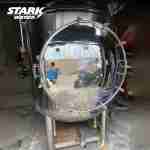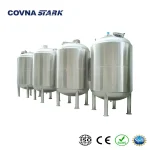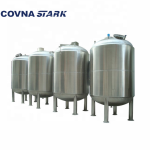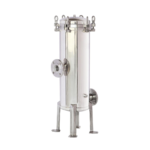Introduction: A Good Water Tank System Starts with Smart Planning
In many industrial water treatment projects, engineers spend weeks designing filtration units, pump sizing, and control panels—but water tanks often receive far less attention. Tanks are seen as “passive containers,” resulting in rushed decisions, copy-paste specs, or last-minute equipment substitutions.
Unfortunately, a poorly chosen or badly integrated tank can undermine the entire water system. From microbial contamination to pressure instability and audit failures, small tank-related issues often create large downstream problems.
This article outlines the five most common mistakes made during industrial water tank system design and provides expert tips to help you avoid costly setbacks. Whether you're planning an RO system, process water loop, or chemical dosing setup, starting with the right tank design will save you time, money, and operational risk.
Mistake #1: Choosing the Wrong Tank Material
One of the most common and costly errors in industrial tank design is selecting an inappropriate material for the storage medium or operating conditions. While it's tempting to choose the most economical option—such as 304 stainless steel or plastic tanks—these materials can quickly degrade or fail when exposed to chemicals, high temperatures, or sanitizing agents.
Examples of Material Mismatches:
- Using PE or PP tanks for hot water or CIP return lines → deformation and cracking under temperature stress
- Using 304 stainless steel for brine, acidic cleaning water, or chloride-rich process liquids → pitting corrosion and rust contamination
- Carbon steel tanks used without proper lining in wastewater storage → internal corrosion and leaching
These mismatches often lead to system downtime, premature tank replacement, product contamination, or non-compliance with audit standards. In many industries, especially food, pharmaceutical, and semiconductor manufacturing, material selection is not a suggestion—it’s a requirement.
Recommended Best Practice:
Conduct a corrosion resistance assessment based on fluid properties, cleaning procedures, and exposure cycles. STARK offers a full range of SUS316L, duplex stainless steel, FRP, and lined carbon steel tanks—each engineered for specific industrial conditions.
Mistake #2: Ignoring Drainage and Dead Zones
Another frequent oversight in industrial tank system design is improper bottom geometry or outlet positioning—leading to water stagnation, residue buildup, and bacterial growth. Many tanks are built with flat bottoms or elevated drain ports, making full drainage impossible during daily operation or cleaning cycles.
Common Problems Caused by Poor Drainage Design:
- Stagnant water accumulation near weld seams or corners → promotes microbial contamination and biofilm formation
- Incomplete discharge of chemical solutions or CIP rinse water → leads to inaccurate dosing or cross-contamination
- Manual cleaning requirements due to inaccessible bottom zones → increases labor costs and system downtime
Even tanks made from sanitary materials like 316L can become breeding grounds for bacteria if water isn't allowed to drain completely and efficiently.
Recommended Best Practice:
Use conical or sloped-bottom tank designs with flush-mounted bottom outlets to eliminate dead legs. Incorporate CIP spray balls and smooth weld transitions to improve cleanability. STARK tanks are engineered with 100% drainability in mind and include sanitary valves, drain ports, and optional self-draining geometry documentation.
Mistake #3: Forgetting to Match Inlet/Outlet with Pipework and Process Flow
Another critical design flaw is misalignment between tank nozzles and the surrounding process line. Whether it’s incorrect flange orientation, incompatible port diameters, or misplaced inlet/outlet positions, these mismatches can lead to significant engineering headaches during installation and commissioning.
Common Issues with Poor Port Matching:
- Incorrect port elevation: causes backflow, air lock, or inefficient drainage when tank is integrated into gravity-fed or pressure-driven systems
- Flange incompatibility: different standards (e.g., DIN vs ANSI) force onsite welding or adapter fabrication, increasing risk and cost
- Flow disruption: sharp directional changes or poorly aligned ports lead to turbulence, pressure drop, or flowmeter reading errors
Even when the tank itself is well-constructed, poor nozzle design can create systemic inefficiencies, complicate automation integration, or require costly last-minute redesigns of skids and pipework.
Recommended Best Practice:
Coordinate process line specifications and layout drawings before fabrication. STARK provides customizable inlet/outlet configurations with detailed 3D models, port elevation drawings, and CAD file sharing to ensure seamless integration with your existing infrastructure.
Mistake #4: Underestimating the Role of Pressure Tanks
In many industrial systems, designers assume that a large enough water tank is sufficient to regulate flow and pressure. However, omitting a dedicated pressure tank often results in unstable flow dynamics, pump stress, and inconsistent feed conditions—especially in RO systems, dosing units, or high-cycle wash processes.
What Happens Without a Pressure Tank?
- Pump Short Cycling: Without hydraulic buffering, pumps start and stop rapidly, leading to wear, overheating, and energy waste
- Flow Fluctuation: Variable demand creates inconsistent pressure, affecting membrane efficiency, chemical dosing accuracy, or equipment startup routines
- Water Hammer Risk: Sudden pressure drops or stops cause damaging hydraulic shock throughout the pipeline
While storage tanks manage volume, pressure tanks regulate pressure stability—a crucial difference that impacts both system longevity and process performance.
Recommended Best Practice:
Integrate pre-charged pressure tanks or diaphragm vessels between the main water tank and high-sensitivity components (e.g., RO membranes or metering pumps). STARK offers pressure tanks sized from 50L to 2,000L+, with stainless steel or composite housings, compatible with food, chemical, and ultra-pure water systems.
Mistake #5: No Documentation for Compliance and Inspection
Even if a water tank is technically sound and functionally integrated, lacking proper documentation can cause significant delays, audit failures, or even regulatory rejection. In industries like pharmaceuticals, food and beverage, or chemical manufacturing, third-party inspections and internal QA teams require full traceability and compliance proof.
Common Documentation Gaps:
- No EN10204 3.1 material certificates: Cannot confirm material origin or corrosion resistance rating
- No weld maps or passivation records: Difficult to validate internal hygiene or sanitary construction
- No pressure or hydrostatic test reports: Raises concerns about tank safety, especially for elevated or pressurized installations
- No CIP/SIP validation compatibility: Fails cleaning verification required by food and pharma standards
Without this documentation, your tank may pass factory tests—but fail on-site inspections, delaying startup or triggering costly remediation.
Recommended Best Practice:
Always source tanks from a supplier who can provide a full compliance documentation package. STARK tanks are delivered with complete files including EN10204 3.1 certificates, weld maps, FAT protocols, pressure test reports, and CIP compatibility notes—ensuring you’re always audit-ready.
Conclusion – Design Once, Save for Years
Water tanks may seem like simple equipment, but when designed incorrectly, they become long-term liabilities. Corrosion, contamination, misalignment, unstable flow, and compliance issues can silently drain resources and delay operations—especially in critical industries where water quality and process control are non-negotiable.
By avoiding the common mistakes outlined in this article, you can extend equipment lifespan, simplify maintenance, pass audits with confidence, and ensure seamless integration with the rest of your water treatment system.
At STARK, we go beyond tank fabrication—we engineer complete water storage solutions that are hygienic, pressure-stable, fully documented, and ready for inspection. Whether you need a single tank or a multi-stage storage layout, our team provides the drawings, certificates, and recommendations you need to build right the first time.
Need help designing your water tank system?
Contact STARK's engineering team
today for layout suggestions, compliance support, or a personalized quote.





